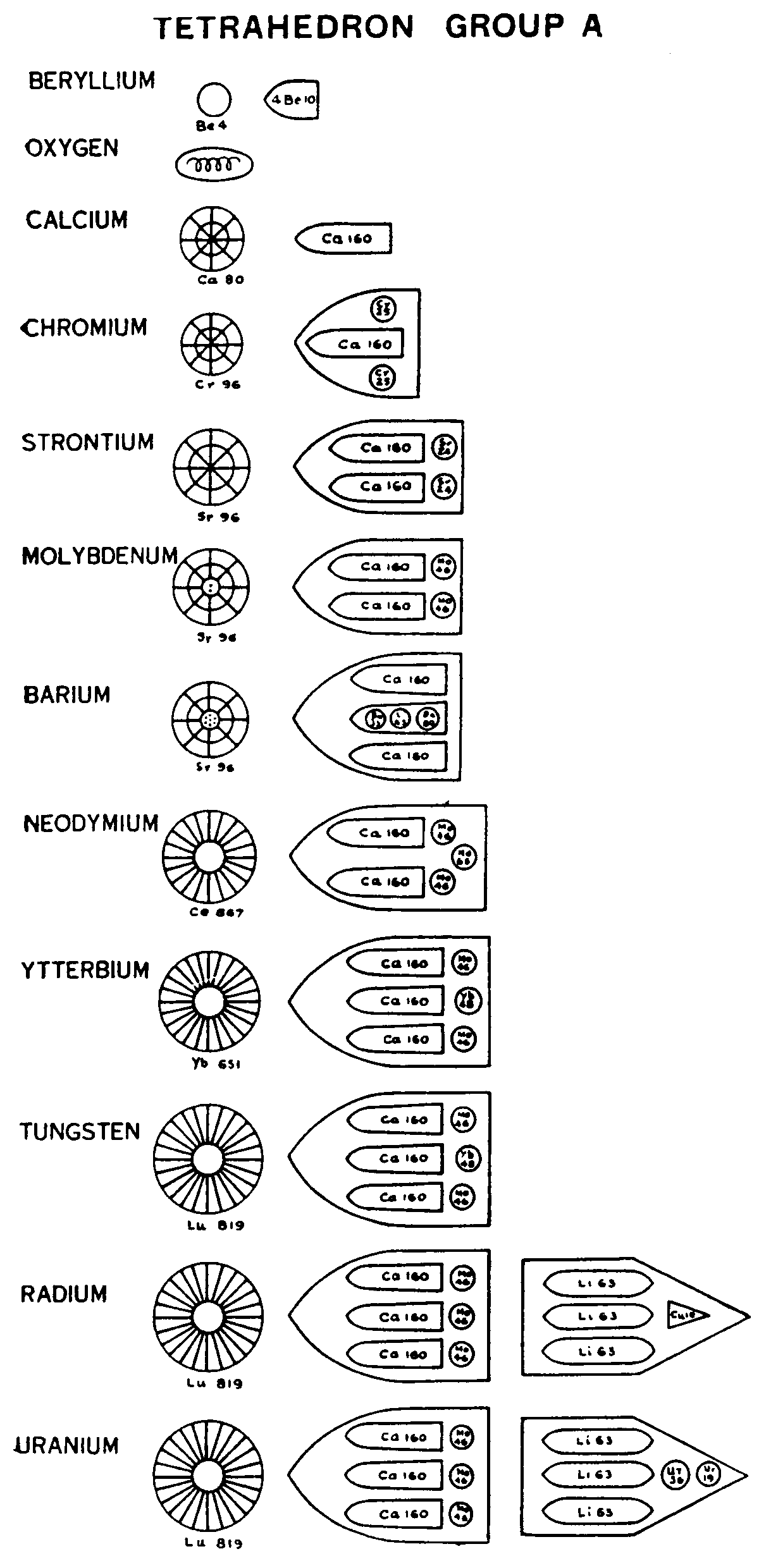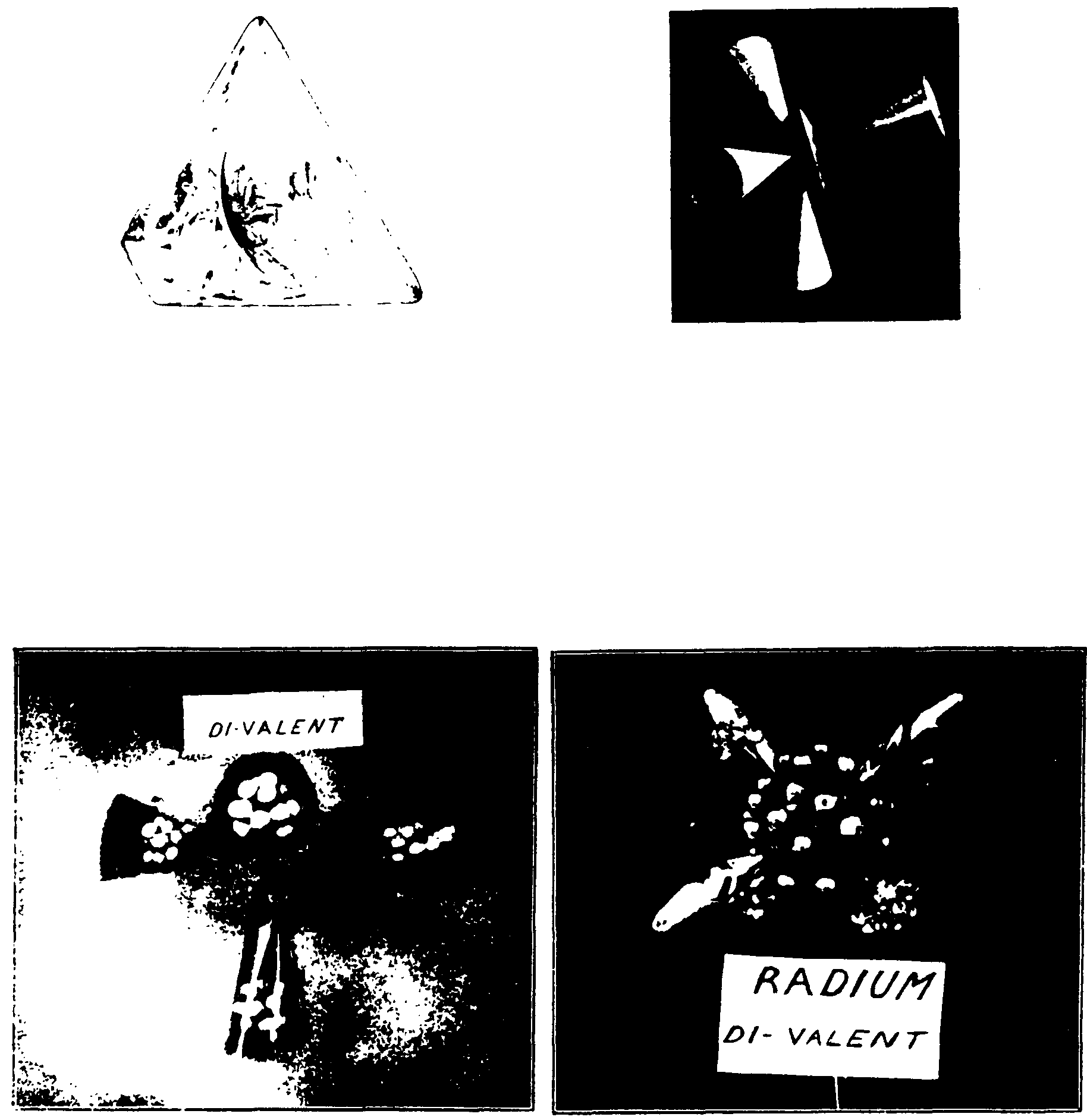
FIG. 42. TYPES OF THE TETRAHEDRON GROUP
CHAPTER V
THE TETRAHEDRON GROUP A

CHAPTER V
THE TETRAHEDRON GROUP A
THE twelve elements in this group occur on the swing of the pendulum to the left of the central line.
They are all tetrahedrons in shape, with the exception of Oxygen, which is ovoid. Their characteristic valence is 2. Each element has four funnels of which two are positive and two negative. The last two elements add 4 spikes directed to the corners of the tetrahedron. Fig. 42.
As
we proceed with this study we shall find how continual are the repetitions,
and how Nature, with a limited number of fundamental methods, creates by
varied combinations her infinite variety of forms.
ATOMIC
ANU ELEMENT CENTRE 4 FUNNELS 4 SPIKES
NO.
4
164 Beryllium Be4 4 (Be10) -
8
290 Oxygen (55N2 + 5.0.7) -
+
(55N2+ 5.07)
20
720 Calcium (8Li4+8Ad6) 4 (Ca45+Ca70 4- Ca45)
24
936 Chromium (8N6+8Ad6) 4 (Ca160+2Cr25) -
38
1,568 Strontium (8B5+8.1.7) 4 (2Ca160+2Sr24) -
42
1,746 Molybdenum (N2+Sr96) 4 (2Ca160+2Mo46) -
56
2,455 Barium (I.7+Sr96) 4 (2Ca160+2Mo46+Ba33
+
Li63b+ Ba80) -
60
2,575 Neodymium (Ce667) 4 (2Ca160+2Mo46+Nd65) -
70
3,131 Ytterbium (Yb651) 4(2Ca160+2Mo46+Ca160
+Yb48)=4Yb620
-
74
3,299 Tungsten (Lu819) 4 (Yb620) -
88
4,087 Radium (Lu819) 4 (3Ca160+3Mo46) 4 (3Li63+Cu10)
92
4,267 Uranium (Lu819) 4 (3Ca160+3Mo46) 4 (3Li63+Ur36
88
OCCULT CHEMISTRY
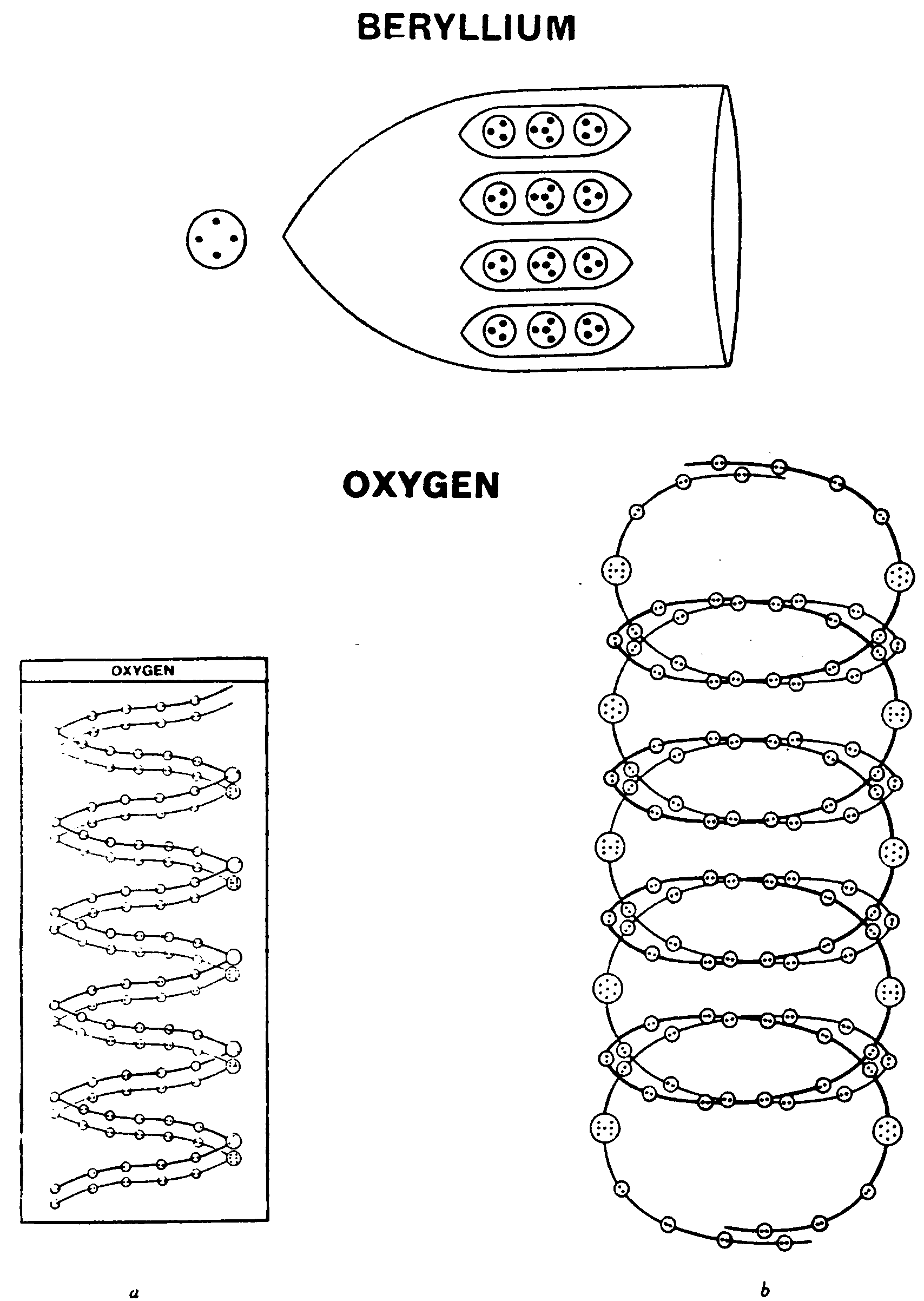
FIG.
43. BERYLLIUM, OXYGEN
THE TETRAHEDRON GROUP A 89
ATOMIC
NO. 4. BERYLLIUM
Beryllium is the simplest member of this group. It consists of four funnels radiating from a central globe, each funnel opening in the face of a tetrahedron. Fig. 43.
Globe.
The globe contains four Anu only. Be4.
Funnels.
Each
funnel contains four ovoids. These ovoids are composed of ten
Anu
arranged as two triplets and a quartet.
Beryllium
= Be4 + 4 (4Be10)
\,
Number weight i$ = 9.11
ATOMIC
No a. OXYGEN
It
was very early noted that Hydrogen, Oxygen and Nitrogen were quite different
in structure from the general run of the elements. Nearly all the elements
are built on the model of the regular solids, tetrahedron, cube and octahedron.
but Hydrogen, Oxygen and Nitrogen seem totally distinct. An interesting
suggestion has been made that these three may in. reality belong to quite
another scheme of elements.
The
gaseous atom of Oxygen is an ovoid within which a spirally-coiled, snake-like
body, with five brilliant points of light shining on each of the coils,
revolves at a high velocity. The snake-like body is really double. one
half being negative and one positive.
Fig.
43a shows diagrammatically this double spiral. Oxygen. however. has an
appearance of solidity due to the fact that the two spirals spin round
a common axis. in opposite directions. and so present a continuous surface.
The brilliant bodies seen in the atom are on the crests of the waves in
the positive snake, and in the hollows in the negative one. small bead-like
bodies interpose between the larger brilliant spheres. These smaller bodies
making up the spirals are very simple, being tiny spheres of two Anu, N2.
The larger spheres have seven Anu, but are of two types, 0.7 and 0.7'.
Fig.
43b is that of the Oxygen atom, showing the two spirals revolving in opposite
directions producing the correct effect of a rounded body. One spiral is
positive and the other negative, and each represents therefore one half
of Oxygen. We shall call each j O. At first sight. the two halves seem
alike, except for the difference in their twist; there is however a fundamental
difference.
Each
j O contains five large spheres of seven Anu. These are different in configuration
according as they belong to the positive j O. or to the negative J O. Fig.
44.
90
OCCULT CHEMISTRY
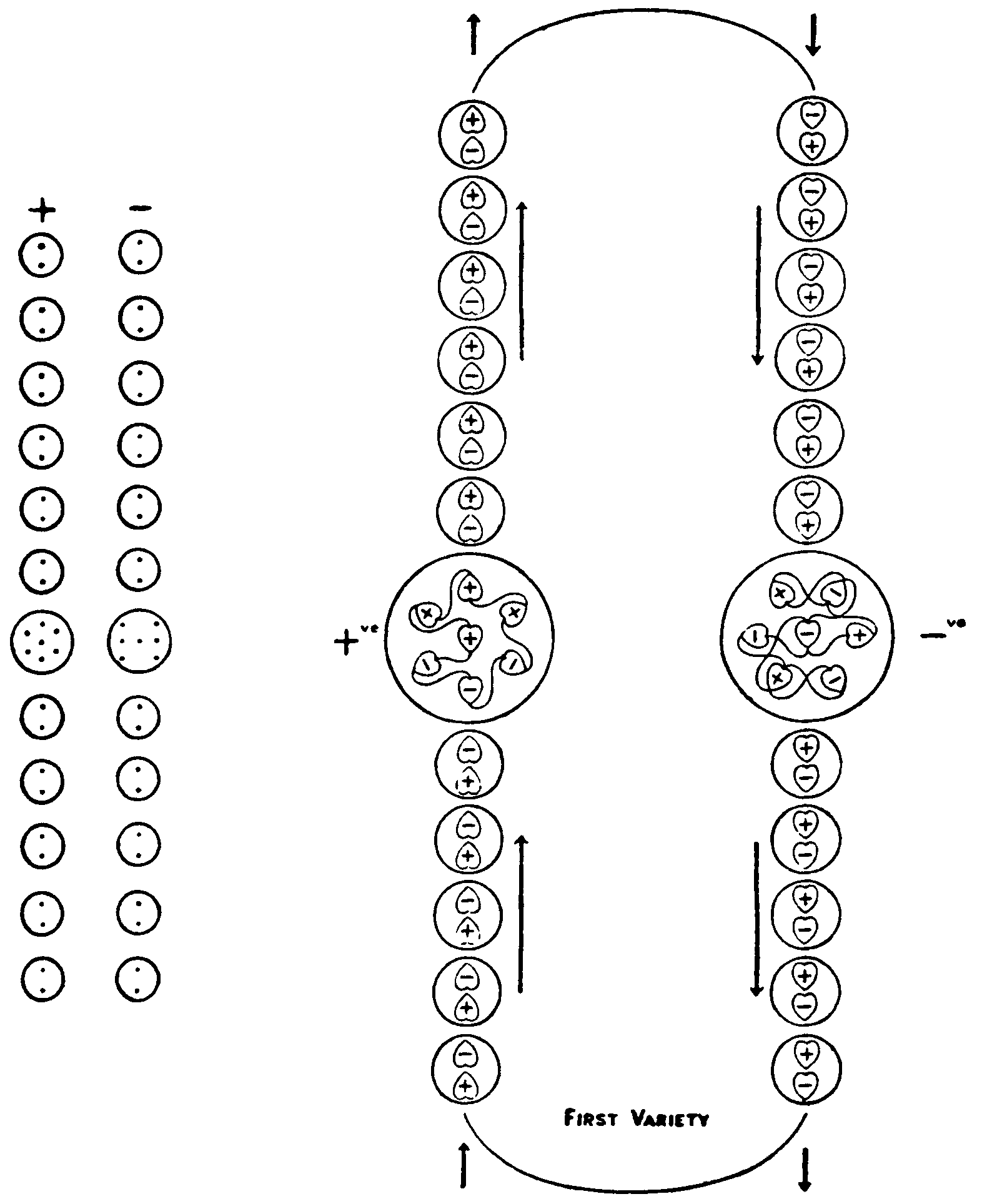
FIG.
44. PART OF OXYGEN, VARIETY 1.
THE TETRAHEDRON GROUP A 91
Each
10 is composed of five sections, which are all alike. A section consists
of a group of 7 Anu, having above it 6 groups of N2, and below it 5 groups
of N2. The five sections join together into one long string of beads, and
then the whole string turns into a spiral.
From
Fig. 44 we can note at once the principal difference in the two halves
of the atom; it is in the group of 7 Anu. In the positive f O the 0.7 is
arranged in a particular way; in the centre is one positive Anu. 6 other
Anu, 3 of them positive and 3 negative. are placed at the 6 points represented
by the centres of the 6 sides of a cube. In the group of 7 Anu in the negative
1O, there is a different arrangement; the centre is formed by one negative
Anu; 6 other Anu, 3 positive and 3 negative. are arranged in pairs on three
levels, one pair on a line with the centre. the other two pairs above and
below at right angles to each other. The median line, however, is not at
right angles to either. but somewhat aslant. To each group of 7 Anu there
are attached 11 groups of 2 Anu. and the arrangement is shown in Fig. 44.
All
this description, however, gives no real idea of"the extraordinarily powerful
nature of the forces which make Oxygen. How many types of force are involved
is not yet known; three however have been noted. The operation of the first
force appears to begin at the central positive Anu of the positive group
of
seven.
That Anu gets charged by the Sun in a special way. The force. which is
like blinding light, radiates out in all directions through the whorls
of the Anu, and draws towards it 6 other Anu, 3 of them positive and 3
negative.
Then
there wells up from the central Anu a second force. From the central Anu
the force flows as indicated by the lines. following always this law, that
a force always flows out from the bottom of an Anu, that is from its pointed
end, and enters in at the top of it, at its heart-shaped depression. In
the positive group of 7 Anu, the force flowing from the central Anu traverses
the other six Anu and re-enters the central Anu at its heart-shaped
depression. A complete circuit is thus made.
In
so completing the circuit, the force causes a third force to manifest,
as if by a kind of induction. It enters from the fourth dimension through
the central Anu. and its operation is dual: first. it charges the group
as a whole and then shoots upwards, and through each duad. It not only
shoots up through them, it brings them into their position as a string
of 6 duads. When it reaches the topmost dead, it shoots upwards still.
if another section of the 10 is above it; if there is no section above,
the force curves over and enters the topmost duad of the negative J O.
and shoots downwards through the 6 duads. If there were not then a group
of 7 Anu the force would rush downwards gathering more duads as pearls
on a string. But on the descent, after the 6 duads, it meets a stream of
force coming to it at right angles.
This
third force also issues from the central Anu of the positive 7 ; it shoots
out at right angles to the ascending force. When the upward force in its
descent meets this force at right angles, a vortex is created, whose effect
is to bring first a negative Anu, and then round it 6 other Anu, three
negative and three positive. When so brought into being this predominantly
negative group of 7 Anu exercises a curious effect on the positive group.
It is as if it existed in order to step down the tremendous energy welling
in the positive seven, so as to make it utilizable for work. The flow of
the force
92
OCCULT CHEMISTRY
within
the negative 7 is as drawn in Fig. 44. But whereas, in the case of the
positive group, the force issues at the bottom of the central Anu in one
stream, here, in the negative group, that force as it issues at the bottom
divides into two streams, each stream traversing three Anu, and then returning
back to the tentral Amu from which it originated. If the diagram is carefully
examined, it will be noted that one stream, for instance that drawn as
going to the right, as it issues from the point of the central negative
Anu, enters into a positive Anu. then enters a negative Anu, then enters
a positive Anu. and then returns
to the negative Anu, from which it enters
into the central Anu. Similarly, the stream marked on the diagram as flowing
from the point of the central Anu to the left enters into a negative Anu,
then enters a positive Anu, then enters a negative Anu, and then
returns
to
the positive Anu, from which it enters into the central Anu. A complete
circuit is thus made.
The
descending force continues to rush down the 5 duads, and then on to the
6 upper duads of the next section. When the last section is reached, the
force curves over to the positive I O and enters it.
The spirally-coiled snake-like body which is Oxygen appears as a snake of white light, but when the snake is separated into its two constituents, the positive 10 and the negative j O, the former is rose-red in colour, and the latter blue.
Oxygen=(55N2+5.0.7)+(55N2-f-5.0.7')
Second Variety of Oxygen
It is mentioned above that from the positive 7 a force shoots out at right angles. After the negative 7 is made there is an interaction between the two. In some Oxygen atoms this interaction produces a kind of stress, and there arises between them a force which flows in from the fourth dimension and holds 4 Anu, two positive and two negative. Fig. 45. These 4 Anu are not encircled by any sphere wall; the force enters all four simultaneously, and does not go out of them. Why this body of 4 Anu exists is
not known; of course it makes a heavier variety of Oxygen.
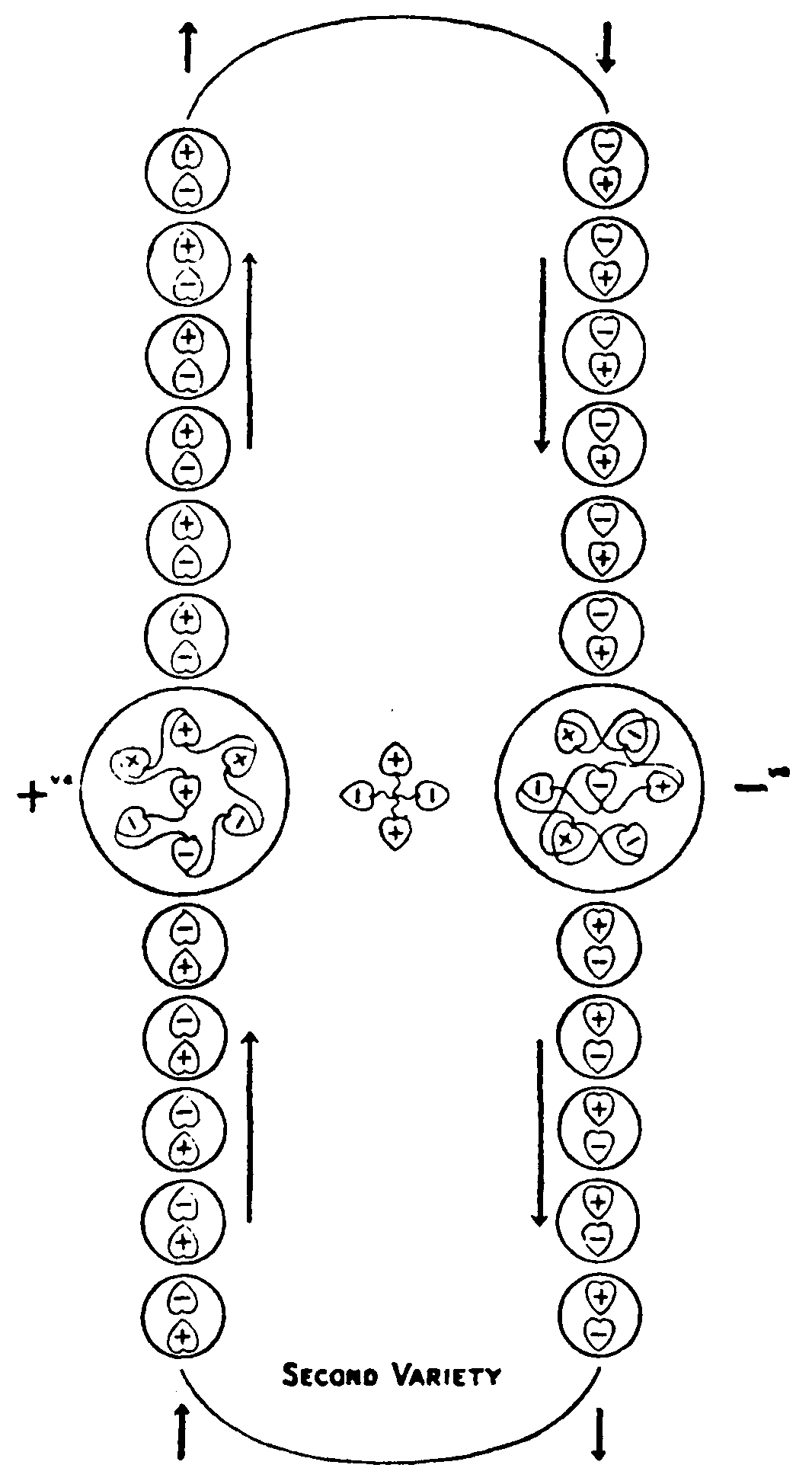
FIG.
45. PART OF OXYGEN, VARIETY 2
94 OCCULT CHEMISTRY
Even
of this second variety, there are two variants. One is as shown in Fig.
45, where in the group of four the two positive Anu are vertical. But there
is a second variant, where the two positive Anu are horizontal. In this
position they are farther apart than when vertical. This gives rise to
two shapes of this second variety. Each Oxygen has its sphere wall, which
is ovoid. The ovoid of the second variety is naturally fatter round the
middle than the ordinary variety. But of the second variety there is one
which is fatter than the other, this being the case when the two positive
Anu are horizontal.
This
is probably not a natural variety, that is, it is not to be found in the
atmosphere. It was artificially constructed, by tacking on to each j O,
to the positive and to the negative, another pair of sections. This produced
a very elongated Oxygen. How long this variety persists is not known, probably
not very long.
In connection with quite a different series of investigations dealing with the problem of Prana or Vitality, an apparently similar group of 7 Anu to that in Oxygen was noted.
But
later investigations showed that the conclusion arrived at that the Vitality
Globule was the same as the brilliant 7 in Oxygen was erroneous, though
the error is easily accounted for. The 7 in Oxygen and the 7 in the Vitality
Globule appear so similar that it is only on close examination that the
very slight difference between them is noted.
THE
TETRAHEDRON GROUP A 95
This slight difference in arrangement makes, however, a great difference in the behaviour of the two groups. It will be seen, in looking at the diagram of Oxygen 7, that the upper part of the group has three positive Anu, showing that, at a certain stage of the flow of force, the force passes into three positive Anu in succession, and then back again into the central Anu. On the other hand, in the Vitality Globule, the force flows alternatively from positive to negative, except of course at the end when the force flows back into the central positive Anu. The fact that there are 3 positive Anu in the upper part of Oxygen brings about a rigidity in the group. It therefore stands upright, as it spins round its axis, with the positive Anu at the zenith.
In the Vitality Globule, however, owing to the fact that the force flows alternatively into positive and negative, the group, though spinning round its axis, is not held rigidly in an upright position. It turns head over heels, or in any direction according to the influence of other forces. Yet both globules are intensely brilliant and not to be distinguished one from the other at a casual glance. Nevertheless, the difference between them is fundamental, as the Vitality group is charged with a force from the Sun which is called Prana or Vitality, which emanates from the Second Aspect of the Logos, while the Oxygen group is charged with a similar force which also comes from the Sun, but from the Third Aspect of the Logos. One group cannot be transformed into the other, because there is a fundamental difference in the forces which play through each. Though no research has been made into the matter, probably the Vitality Globule does not enter into chemical combination with other groups.
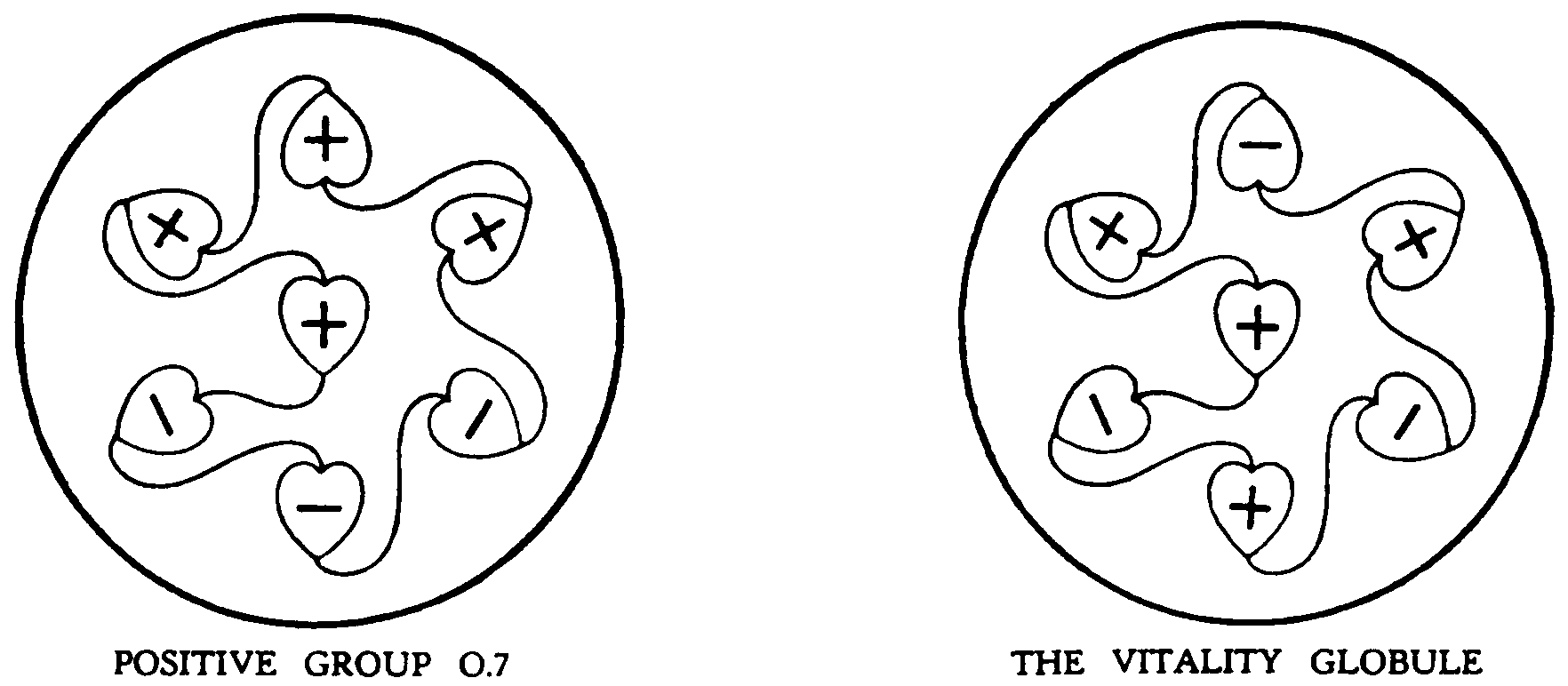
OZONE
The
appearance of Ozone is indicated in Fig. 47. It is composed of three Oxygen
snakes, that is, of one Oxygen atom of two snakes, and a third extra snake
of half Oxygen. These three snakes are at the points of an equilateral
triangle. They are on one plane, so that as they revolve, the large bodies
within each snake come together at the nodes. Ozone being thus I (O ),
it is found that there are two varieties of Ozone. Fig. 47 shows one variety
made of two positive snakes and one negative. The second variety of Ozone
is composed of two negative snakes and one positive.
A
surprising fact was noted, that the first variety of Ozone, i.e., two positive
and one negative, always rose in the air. It cannot be lighter, because
the number of Anu in both varieties of Ozone are the same, that is 435.
No investigation was made to decide whether positive Ozone rose because
of some repulsion to gravity, or because there was some force of a positive
electrical quality radiating from the earth from which positive Ozone rebounded.
At the height of the Blue Mountains near Sydney, about 3,000 feet above
sea level, all the specimens examined of Ozone were positive. Compared
with negative Ozone, the positive variety gave a specially clean impression,
suggesting that perhaps the sense of cleanness of the air in mountain regions
may be due less to the absence of dust particles and more to the presence
of positive Ozone.
It was noted that Ozone j (03) has a tendency to revert to Oxygen, leaving one snake to go and find a mate for itself. It was also noted that electrical action breaks up Oxygen into its two constituent halves.
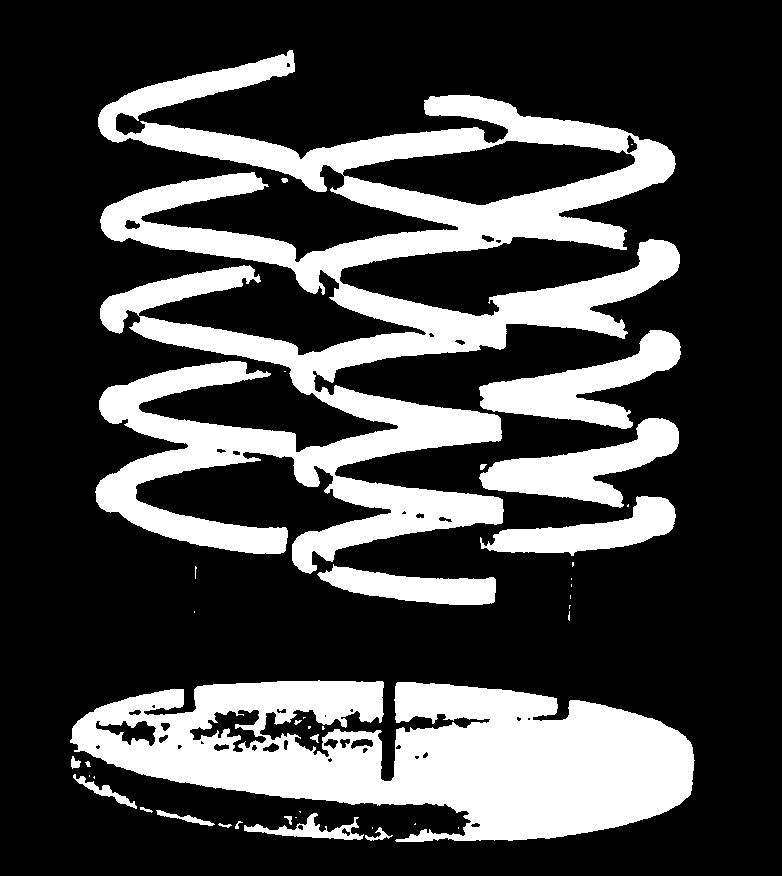
FIG.
47. OZONE
THE TETRAHEDRON GROUP A 97
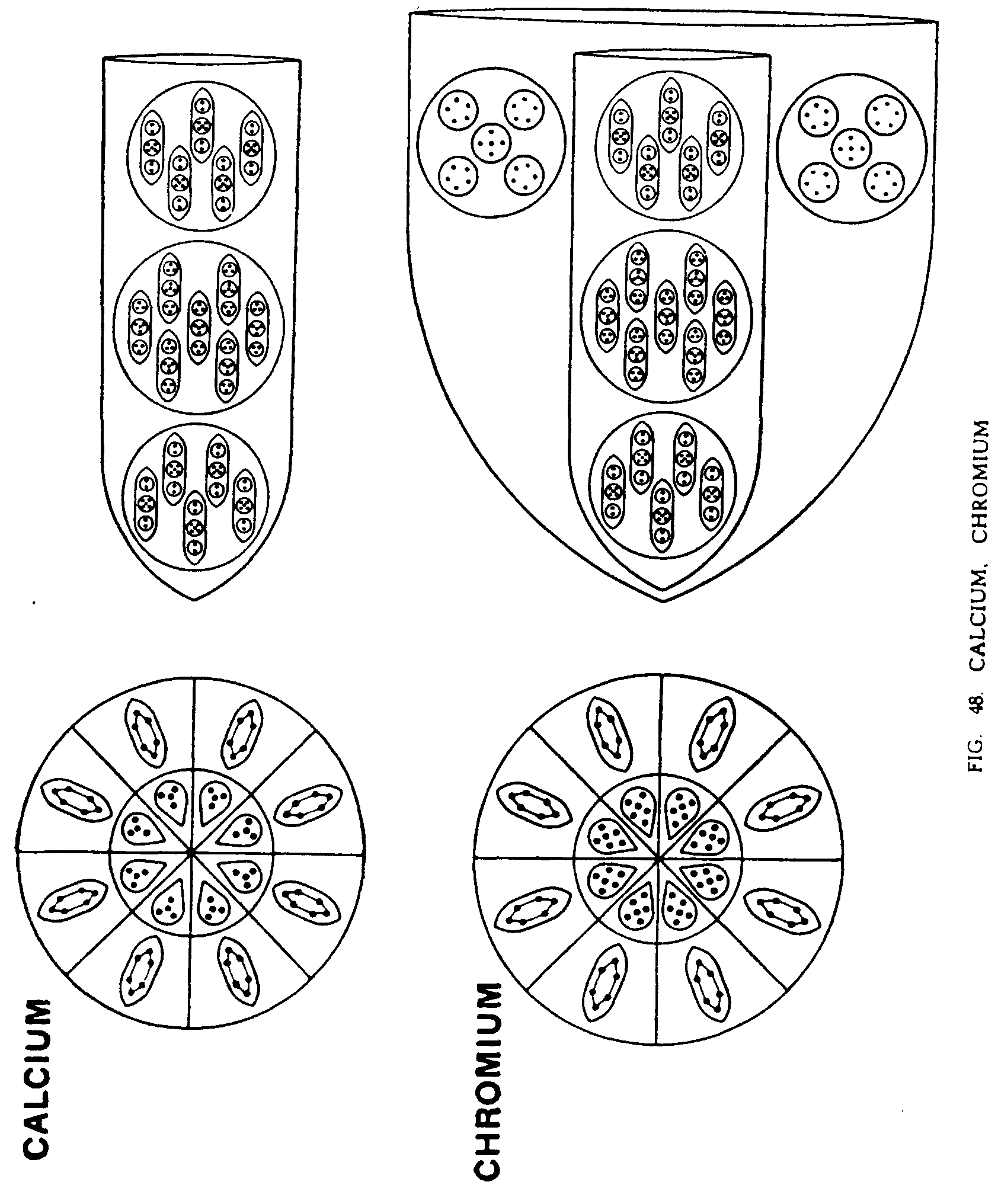
FIG. 48. CALCIUM,
CHROMIUM
ATOMIC
N0.20. CALCIUM
Calcium
follows the pattern of Beryllium, but 720 Anu are packed into the simple
Beryllium form. Fig. 48.
Central
globe. The central globe is double, globe within globe, and is divided
into eight segments radiating from the centre like an orange, the internal
part of the segment. that belonging to the inner globe, has a triangular
body within it containing four Anu, Li4. The external part, belonging to
the encircling globe, shows the familiar Ad6.
Funnels. Calcium contains in each funnel three spheres, of which the central one. Ca70, has within it seven ovoids, Be10, identical with those of Beryllium. The spheres, Ca45, above and below the central sphere, each contain five ovoids each of 9 Anu. The funnels
thus
contain 160 Anu and may be distinguished as Ca160. The spheres Ca70 and
Ca45
occur
frequently.
Calcium
= (8Li4+8Ad6)+4 (5Al9'+7Be10+5AL9')
=
Ca80 +4 (Ca45+Ca7O+Ca45)
=
Ca80 +4 (Ca160)
Number
weight ~ = 40.00
ATOMIC
NO M. CHROMIUM
Central
globe. The globe is identical with that of Calcium as regards its external
segments. In the internal segments the group N6 is substituted for the
Li4. Fig. 48.
Funnels. The funnels are very similar to those of Calcium save that two extra spheres are added, the funnels being widened to accommodate them. Each funnel contains the three spheres which form the Calcium funnel, Ca160, and two extra spheres, Cr25. These two extra spheres contain five quintets of which two pairs are to each other as object and image.
Chromium = (8N6+8Ad6)+4 (Ca160+2Cr25)
Number
weight 936 = 52.00
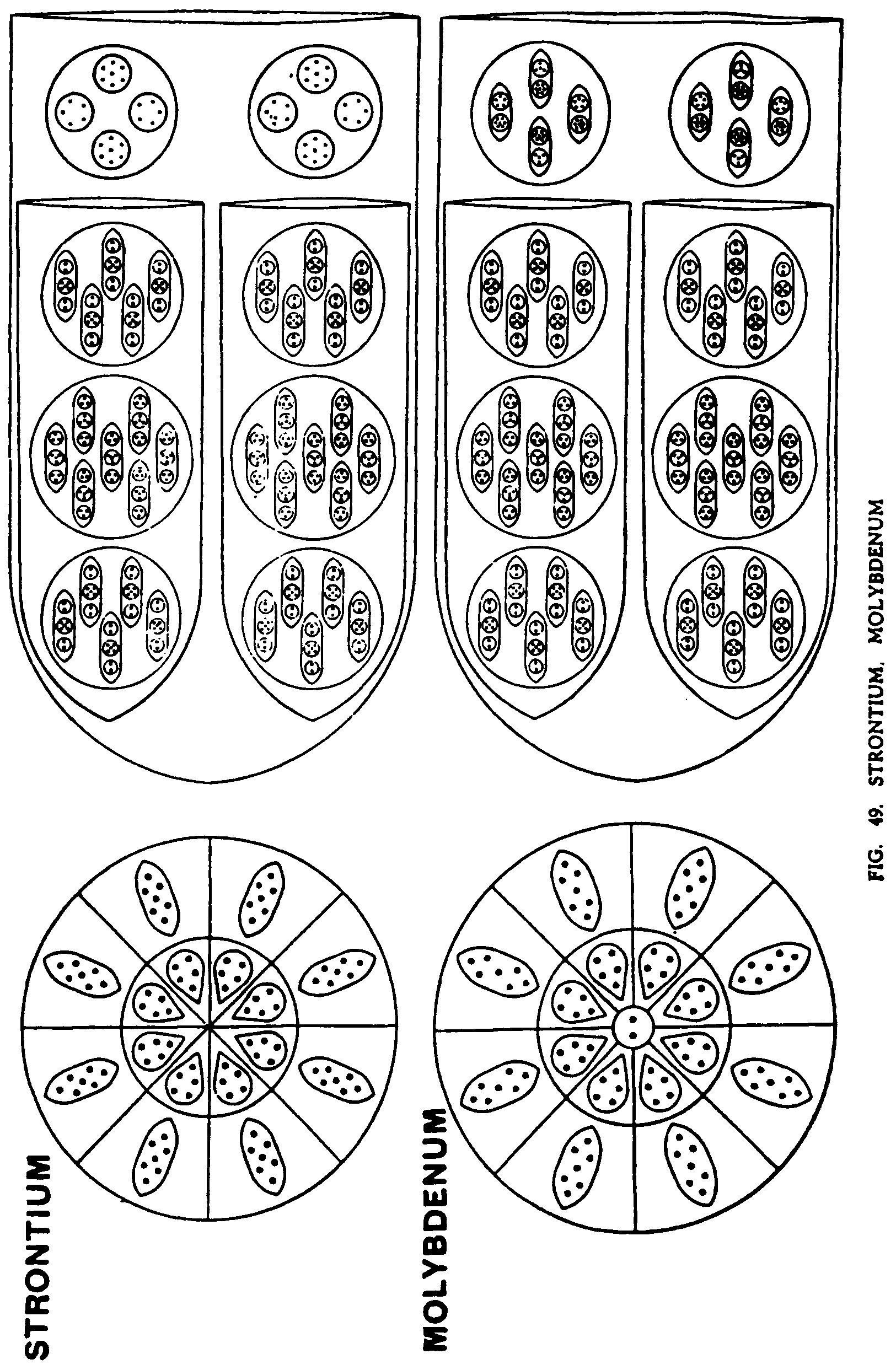
THE TETRAHEDRON GROUP A 99
ATOMIC
NO 3s.
STRONTIUM
Central
globe. The number of the divisions of the double sphere of the central
globe is the same as in Calcium, but the contents differ. The cigars, Ad6,
in the external segments are replaced by ovoids containing seven Anu, 1.7.
The internal segments contain triangles with five Anu. The whole makes
up Sr96. Fig. 49.
Funnels. Within the funnel there are eight spheres. The six lower spheres are identical with those in Calcium and make up two Calcium funnels, i.e. 2Ca160. Each of the highest pair of spheres. Sr24, contains four subsidiary spheres, with groups of 5, 7, 7 and 5 Anu respectively. These are B5, 1.7.1.7 and B5. The 1.7 groups are identical with those in Gold. but the difference of pressure in Gold makes the containing body spherical instead of ovoid; similar groups are seen in the top ring of the Iodine funnel, where also the group is oval in form.
Strontium
= Sr96+4 (2Cal6O+2Sr24)
Central
globe --- 96 Anu
4
funnels of 368 Anu = - 1472 _
Number
weight ~ = 87.11
ATOMIC
NO. 42.
MOLYBDENUM
This
element closely resembles Calcium and Strontium. It differs from Strontium
only in the composition of the highest pair of spheres in the funnel, and
in the presence of a little sphere containing two Anu in the middle of
the central globe. Fig. 49.
Central
globe. The outer sections of the central globe contain the group 1.7. and
the inner sections contain the groups B5, exactly as in Strontium. In addition
we find a sphere of two Anu, N2, in the centre of the globe.
Funnels. Each funnel contains two complete Calcium funnels, 2Ca160, as in Strontium. The two topmost spheres in the funnel each contain eight smaller spheres. Two of these are Li4, two B5 and four 1.7, making 46 Anu in all, Mo46. The total in one funnel is thus 2Ca160+2 Mo46, making 412 Anu.
Molybdenum
= (Sr 96-I-2)-f-4 (2Cal6O+2Mo46)
Central
globe = 98 Anu
4
funnels of 412 Anu =- 1648 _
Number
weight 118 97.00
1m
OCCULT CHEMISTRY
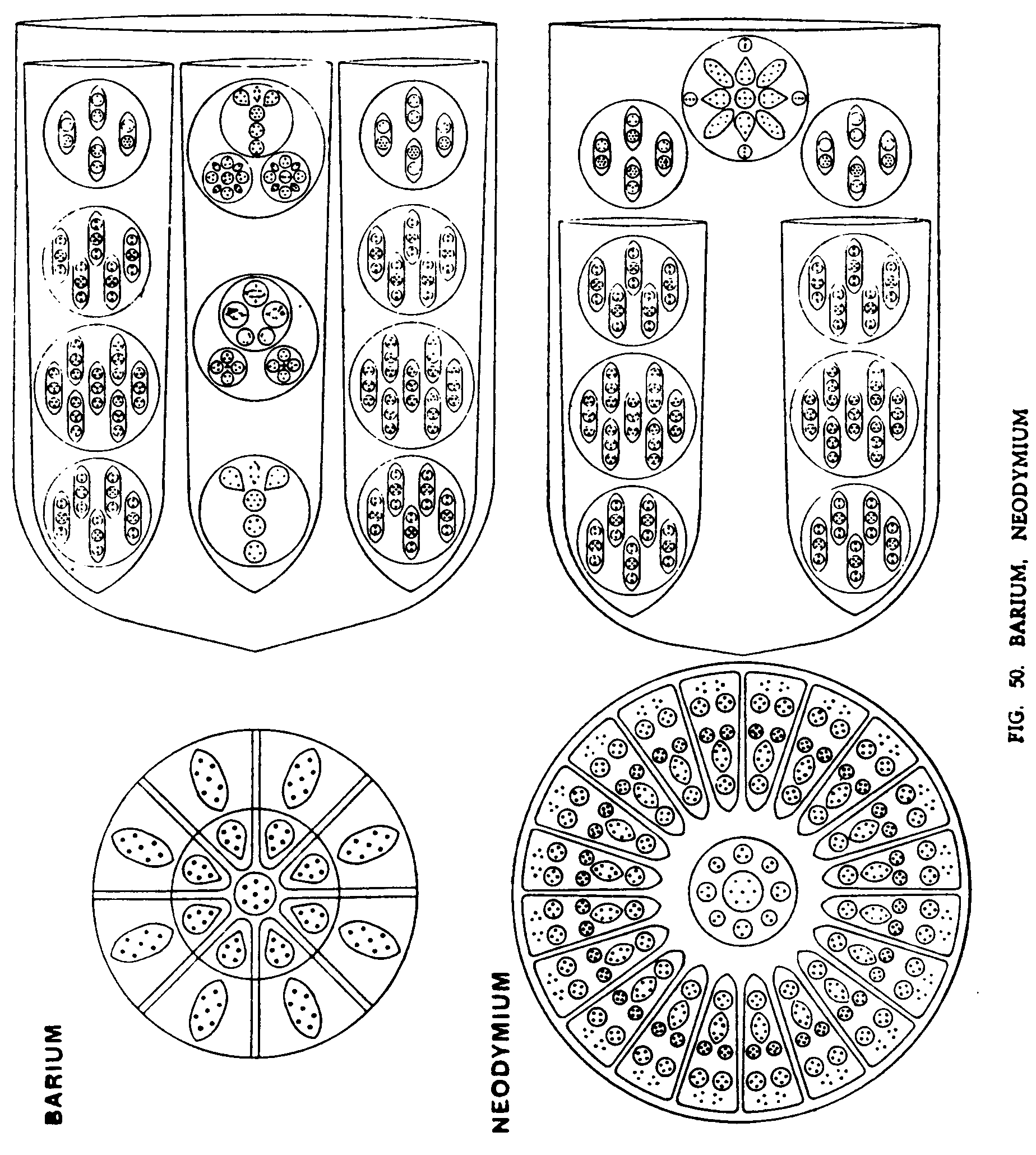
THE
TETRAHEDRON
GROUP A 101
ATOMIC
NO. 56. BARIUM
This
element closely resembles Calcium and Strontium but introduces some new
bodies into its funnels and globe. Fig. 50.
The
Central globe is exactly similar to that of Strontium, save that it
has an 1.7 in the centre.
Funnels.
In
the funnels we find two Calcium funnels, 2Ca160, at the head of each of
which appears the sphere Mo46. Within the funnels appears also a third
rather complex segment. It contains first a new body Ba33, consisting of
four fives and a seven, and an Ad6 group round which two of the lives revolve.
This body, Ba33, is destined to play a prominent part in the powerful central
globe of Radium.
We find next, in this central segment in the funnel of Barium the material of the Lithium spike, Li63, re-arranged as a sphere. This may have been borrowed from the adjacent element Caesium. The third sphere, Ha80, in this segment, contains the group Ba33, with two attendant spheres of 24 and 23 Anu respectively, which suggest in their arrangement the centre of the globe of Lutetium and Radium.
Barium
= _ (Sr96+I.7)+4 (2Ca160+2Mo46+Ba33+Li63b+Ba 80)
Central
globe = 103 Anu
4
funnels of 5$8 Anu = 2352 _
Number
weight ~ = 136.4
ATOMIC
N0.60.
NEODYMIUM
This
element much resembles Molybdenum in respect of its funnels, but has a
much larger central globe. Fig. 50.
Central
globe.
The globe has a central portion of 27 Anu, which is also found in Cerium,
as well as in the later members of the group. Tungsten and Uranium.
Round
this centre we find 20 segments, each containing a group of 32 Anu very
similar to the group Ba33 found in Barium and Radium. The whole is similar
to that of Cerium, Ce667.
Funnels. In each funnel we find first two complete Calcium funnels, 2Ca160, then two spheres Mo46, and finally a completely new sphere. It is composed of a quintet M-NeS, then 4 quintets B5, then four L7 and 4 triplets, arranged so as to form a symmetrical pattern as shown. The whole make the group Nd65.
Neodymium
= (Ce27+2OCe32)+4 (2Ca160+2Mo46+Nd65)
Central
globe = 667 Anu
4
funnels of 477 Anu = 1908
Number
weight 85 = 143.06
102
OCCULT CHEMISTRY
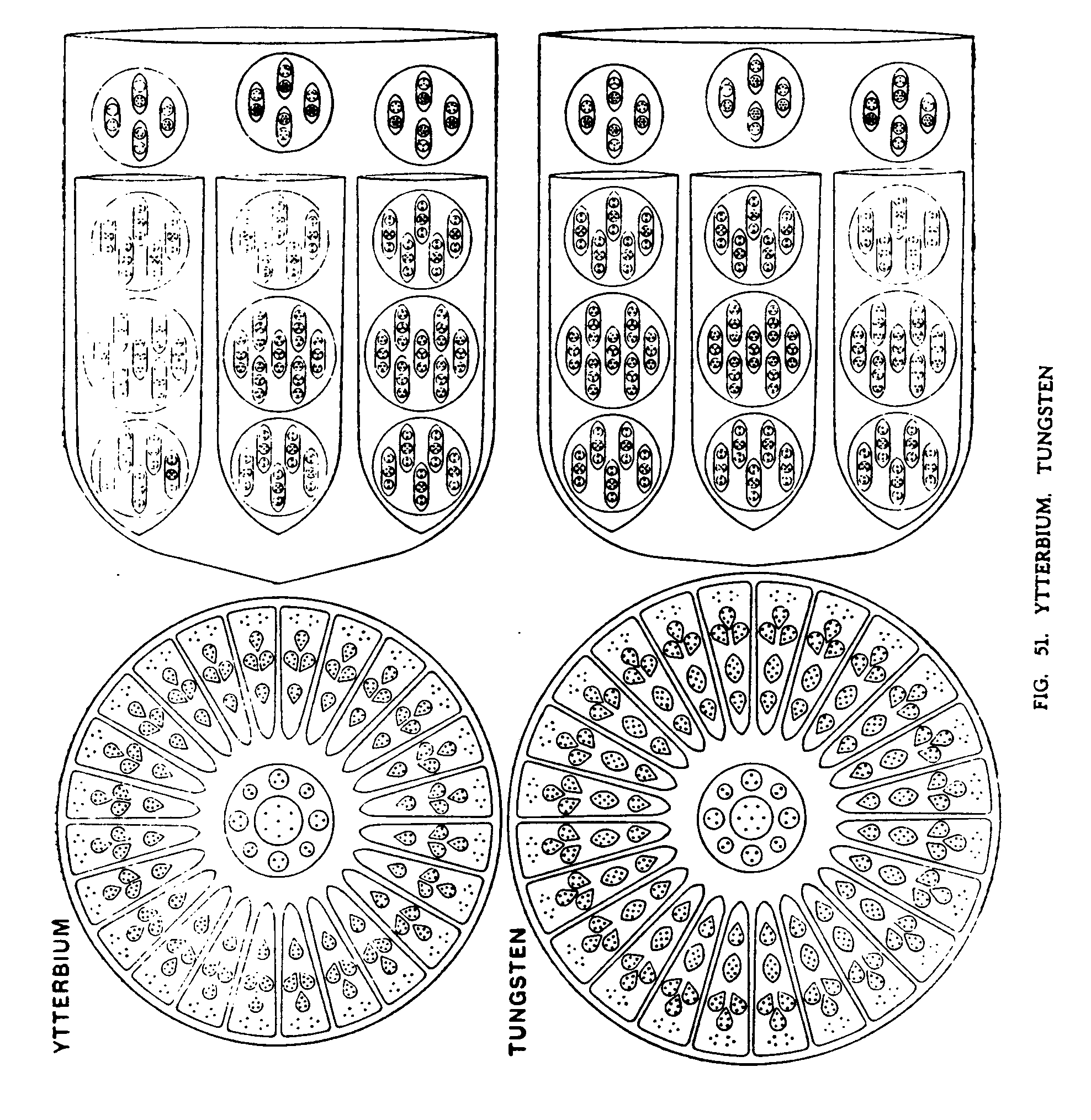
ATOMIC
NO. 70. YTTERBIUM
This
element is built up in a manner somewhat similar to Neodymium. Fig. 51.
Central
globe. The centre-piece of the globe is Ce27. Round this radiate 24
segments, each of 26 Anu, Yb26. This central globe contains 651 Anu.
Funnels. Each funnel contains three Ca160, two Mo46 and a new sphere Yb48, making up 620 Anu. The sphere Yb48 consists of four ovoids each containing
twelve
Anu.
Ytterbium
- (Ce27+24Yb26)+4 (2Ca160+2Mo46+Ca160+Yb98)
Central
globe = 651 Anu
4
funnels of 620 Anu = 2480 _
Total = 3131 Anu
Number weight 3181 = 173.94
ATOMIC
NO. 71. TUNGSTEN
Tungsten
may be said to be a stage between Ytterbium and Radium. In fact Tungsten
is almost exactly Radium without the spikes which are the distributive
agency of Radium. Its central sphere. Lu819, is identical with that of
Radium, except that the six Anu at the outer end of each section are not
equidistant but are definitely arranged in the cigar form. In the case
of Radium it is evidently the speed of revolution which overcomes their
cohesion. In Tungsten the speed of revolution is much less, and the element
is only slightly radio active. The funnels of Tungsten are almost identical
with those of Radium, except that Tungsten contains two more Anu in each
funnel Fig. 51.
Central
globe. The globe consists of a central sphere, Ce27, and 24 sections
containing Ba33, making up 819 Anu in all. This sphere is first met with
in Lutetium and is therefore identified as Lu819. As has been pointed out
above, it occurs in Radium and other radio-active elements.
Funnels. The Tungsten funnels are exactly like those of Ytterbium. Each funnel contains three sections, first three Calcium funnels, Ca160, and then two Mo46 spheres
and
one Yb48.
Tungsten
= Lu819+4 (2 Ca160+2Mo46+Ca160+Yb48)
Central
globe = 819 Anu
4
funnels of 620 Amu = 2480
Total = 3299 Anu
Number
weight ~ = 183.3
104
OCCULT CHEMISTRY
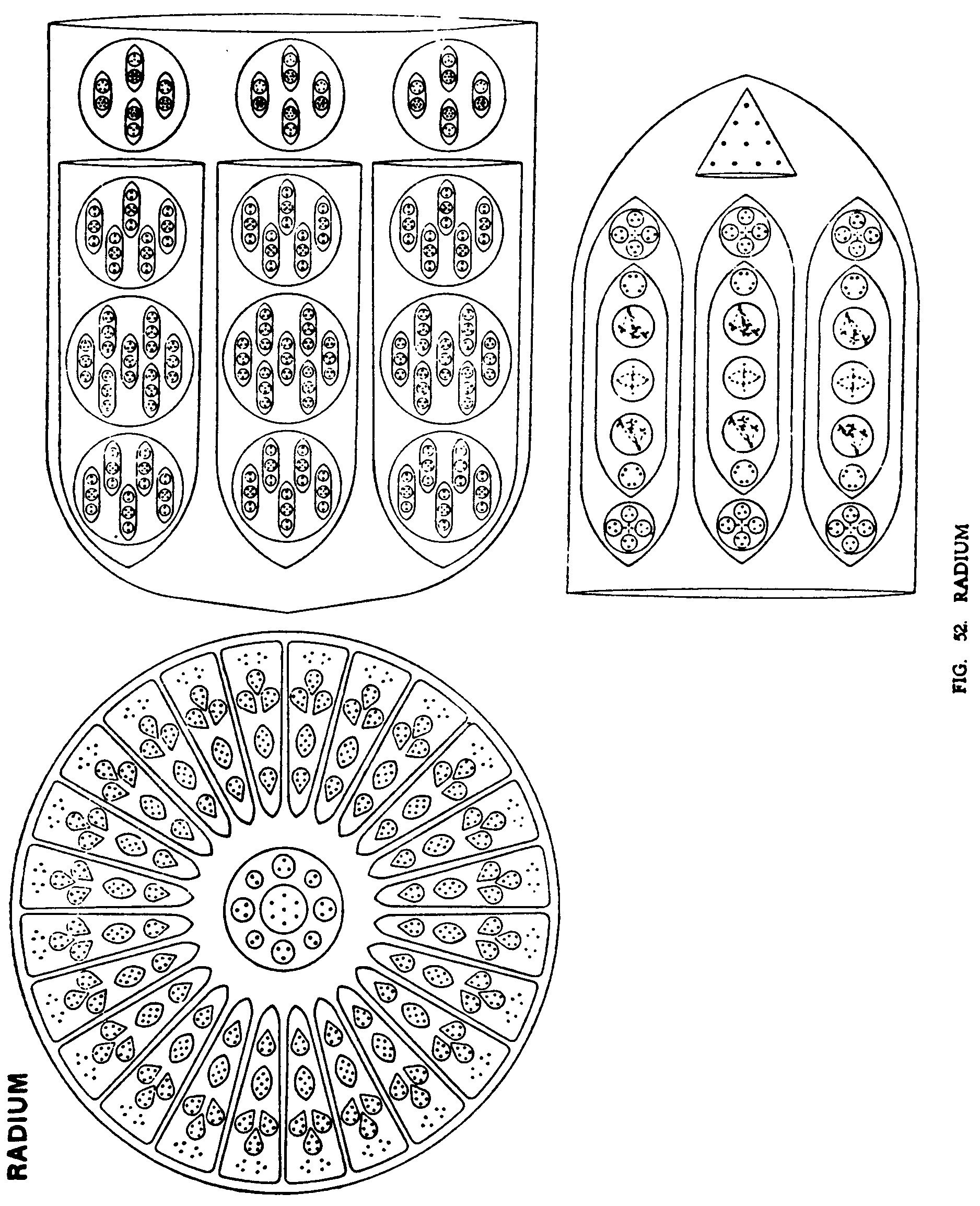
THE
TETRAHEDRON
GROUP A 105
ATOMIC
NO. 88. RADIUM
Radium
is built on a pattern similar to the other elements of its group. Fig.
52.
Central
;globe. Radium has a complex central sphere, Lu819, extraordinarily
vivid and living; the whirling motion is so rapid that continued accurate
observation is very difficult; the sphere is more closely compacted than
the centre-piece in many other elements, and is much larger in proportion
to the funnels and spikes than is the case with some of the other elements
in the group; in the lighter elements the funnels are much larger than
the centres, whereas in Radium the diameter of the sphere and the length
of the funnel or spike are about equal. The heart of the sphere is a globe
containing seven Anu. This globe is the centre of two crosses, the arms
of which show respectively groups with two and three Anu. Round this central
sphere are arranged, as on radii, twenty-four segments, each containing
five bodies, as in Ba33--four quintets and a septet-and six loose Anu,
which float horizontally across the mouth of the segment; the whole sphere
has thus a kind of surface of Amu.
In
the rush of the streams presently to be described, one of these Amu is
occasionally torn away, but is generally, if not always, replaced by the
capture of another which is flung into the vacated space.
Funnels.
The
funnels are identical with those of Tungsten except that they contain two
fewer Anu. We find first the three Calcium funnels, 3 Ca160, and then three
Mo46, instead of two Mo46 and one Yb48.
The
three sections in the Radium-funnel are thus similar to one another. They
stand at the corners of a triangle and not side by side.
Spikes.
Radium has four -sees alternate with the funnels and pointing to -the angles
of the tetrahedron. Each spike contain three Li63 and a cone or cap of
ten Anu, Cu10, floating above the three Li63.
A very peculiar result, so far unobserved elsewhere, arises from the extraordinarily rapid whirling of the central sphere. A kind of vortex is formed, and there is a constant and powerful indraught through the funnels. By this, particles are drawn in from without, and these are swept round with the sphere; their temperature becoming much raised, and they are then violently shot out through the spikes. It is these jets which occasionally sweep away an Anu from the surface of -the -sphere. These particles may be single Anu, or they may be bodies from any of the etheric -levels; in some cases the bodies break up and form new combinations. In fact Radium seems like a kind of vortex of creative activity, drawing in, breaking up, recombining, shooting forth-a most extraordinary element.
Radium = Lu819+4 [3 (Ca160+Mo46)[+4 (3Li63+Cu10)
Central globe = 819 Anu
4 funnels of 618 Anu = 2472
_
4 spikes of 199 Anu = 7% _
Total = 4087 Anu
Number
weight ~ .-- 227.05
OCCULT
CHEMISTRY
106
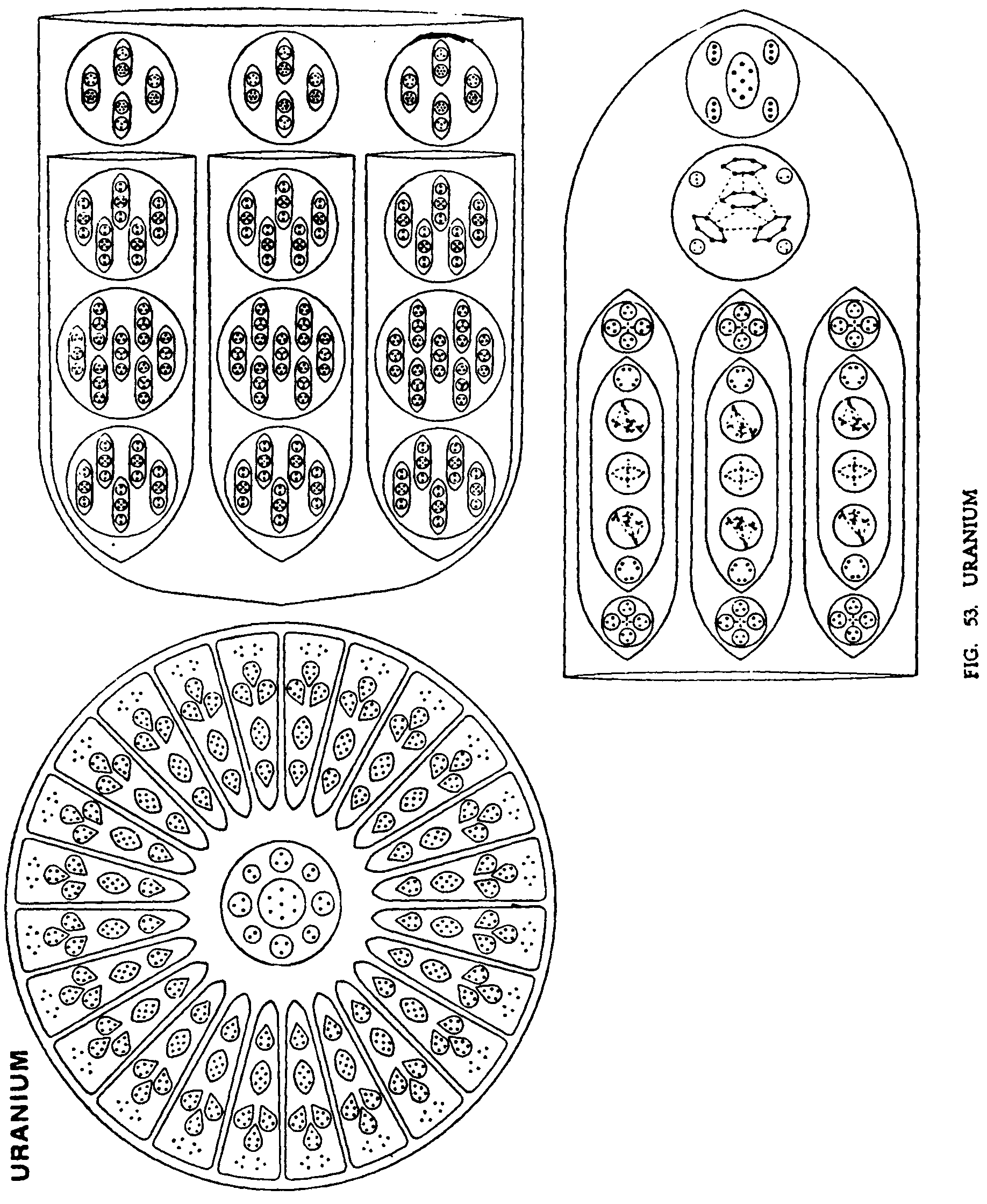
THE
TETRAHEDRON GROUP A 107
ATOMIC
NO. 92 URANIUM
Uranium
is formed on the same pattern as Radium, but is far less active. It has
four spikes as well as four funnels. Fig. 53.
Central
Globe. This is similar to that of Lutecium, Tungsten and Radium, except
that the six Anu at the outer end of each section are not
equidistant,
but definitely arranged as a cigar. In this it follows Tungsten.
Funnels.
The
four funnels are exactly similar to those in Radium. Each contains three
Calcium funnels. 3 Ca160, and three Mo46 spheres.
Spikes. The four spikes contain the three Lithium spikes as in Radium, but instead of the little cap of ten Anu there come two small globes. One of these contains Ad24 and 4 triplets, Ur36, and the other, four triplets and one L7 s Ur19. The first of these spheres, Ur36, contains components of a Helium atom. Here we have the suggestion of the composition of the Helium atom that we should expect, since Helium is produced by the disintegration of Uranium.
Uranium
= Lu819+4 [3 (Ca160+Mo46) J+4 (3Li63+Ur36+Url9)
Central
globe = 819 Anu
4
funnels of 618 Anu = 2472 _
4
spikes of 244 Anu = 976 _
Total
= 4267 Anu
Number
weight
~
= 237.06
OCCULT
CHEMISTRY
FIG.
54. DISINTEGRATION - QF BERYLLIUM
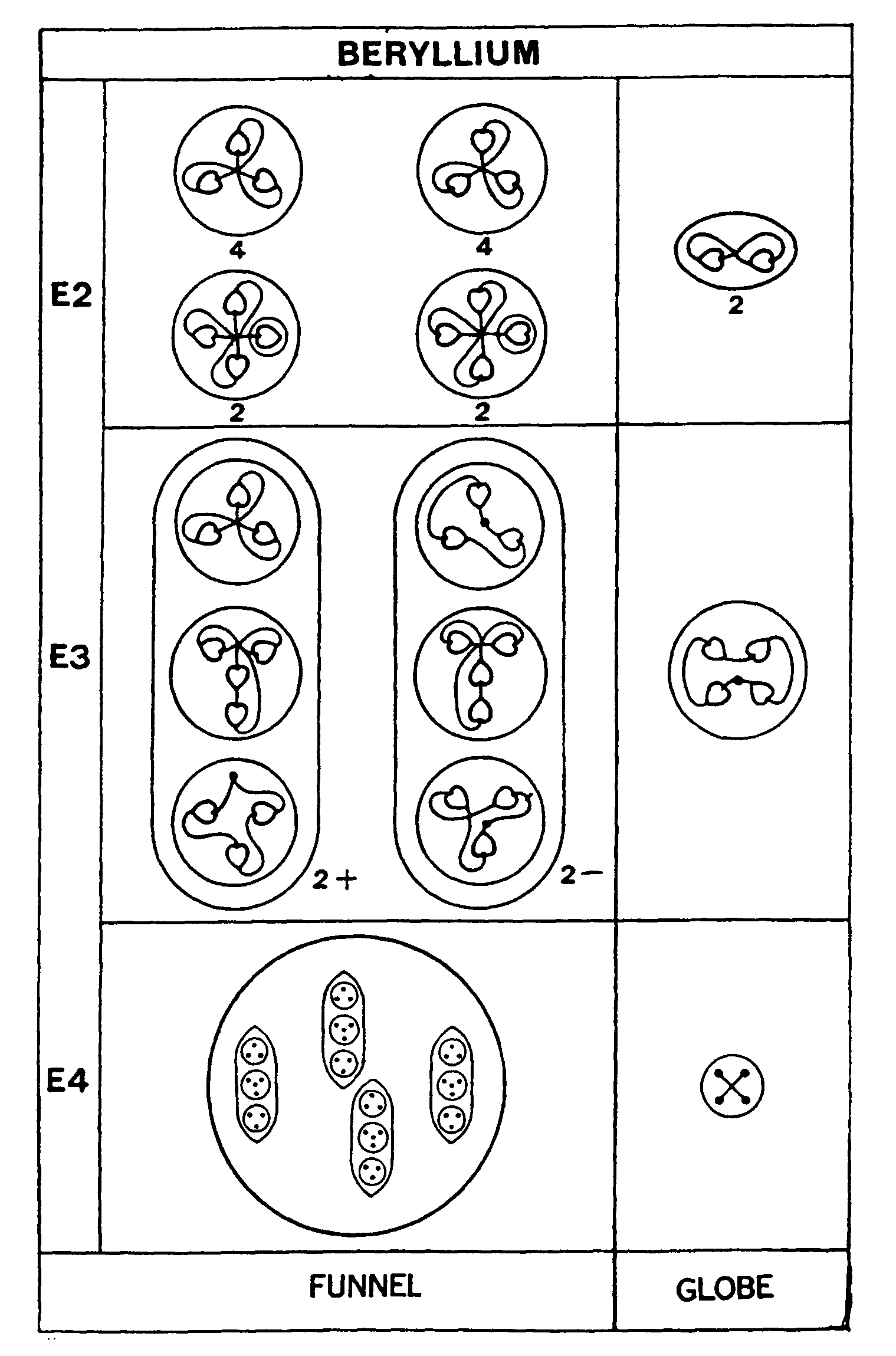
THE
TETRAHEDRON
GROUP A 109
DISINTEGRATION OF THE TETRAHEDRON GROUP A
DISINTEGRATION OF BERYLLIUM
This element contains four similar funnels and a central globe. The E4 groups consist of these five bodies set free. Fig. 54.
Each funnel, released from pressure, assumes a spherical form, with its four ovoids, Be10, spinning within it.
On the E3 level, these four ovoids, Be10, are set free, and two from each funnel are seen to be positive and two negative.
On the E2 level these decads each disintegrate into two triplets and a quartet, the positive with the points outward, the negative with the points inward.
The central globe on the E4 level remains a sphere containing a whirling cross.
On
the E3 level the cross shows a change in the resultant force-lines, preparatory
to its breaking into two duads an the E2 level.
110
OCCULT CHEMISTRY
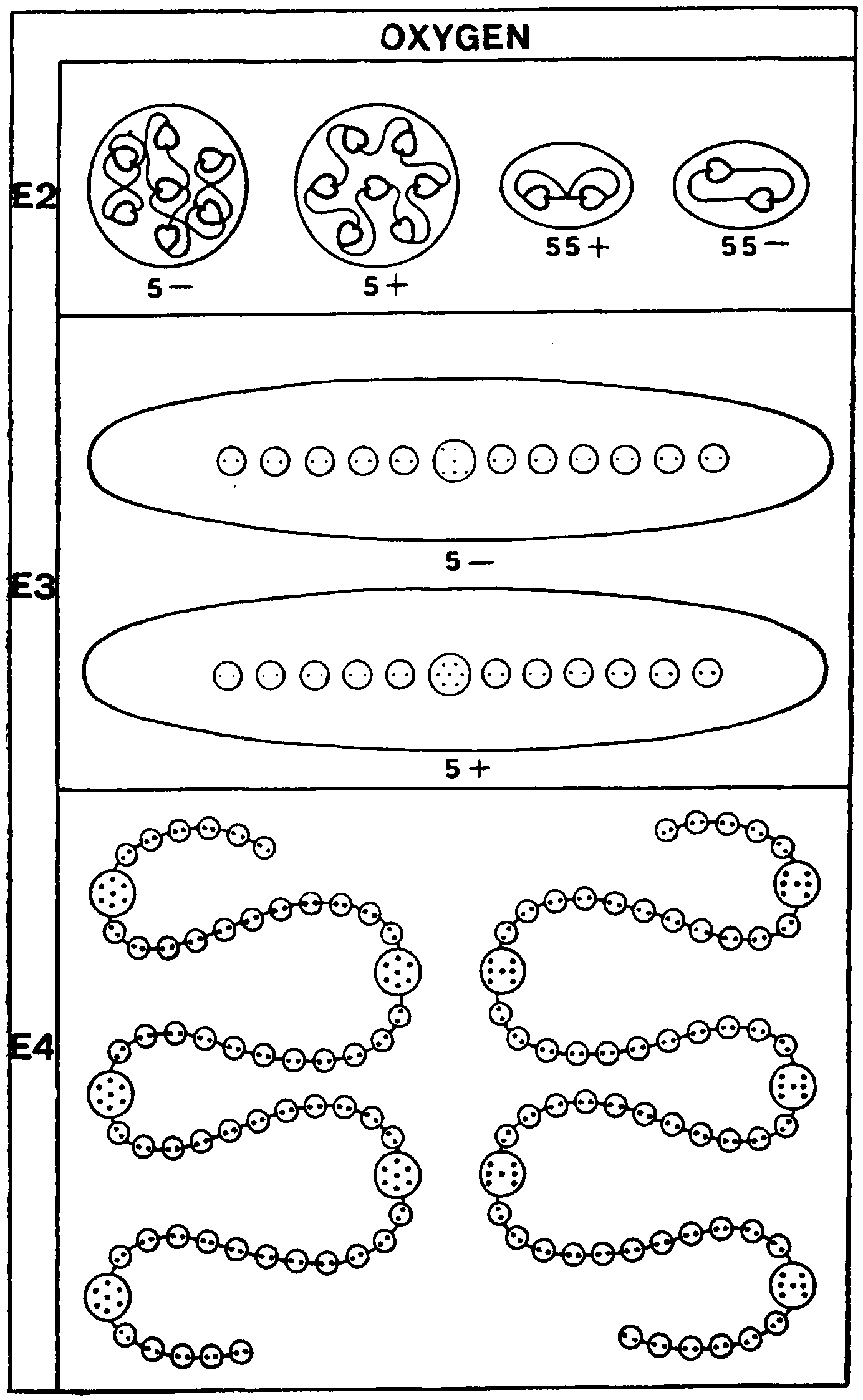
FIG.
55. DISINTEGRATION OF OXYGEN
THE TETRAHEDRON GROUP A 111
DISINTEGRATION OF OXYGEN
On the E4 level the two snakes divide. The positive and negative snakes each consist of fifty-five duads and five brilliant discs. These discs have seven Amu but are differently arranged; those in the positive snake have the Anu arranged as in the Iodine ovoids, 1.7, whereas the negative snake has them arranged as in a capital H. The snakes show the same extraordinary activity on the E4 level as on the gaseous, twisting and writhing, darting and coiling.
On the E3 level the snakes break into 10 fragments, each consisting of a disc, with six beads, N2, on one side and five on the other, remaining as lively as the original snake.
On
the E2 level the snakes shiver into their constituent discs and beads,
there yielding the ten discs, five positive and five negative, and 110
beads, 55 positive and 55 negative.
112
OCCULT CHEMISTRY
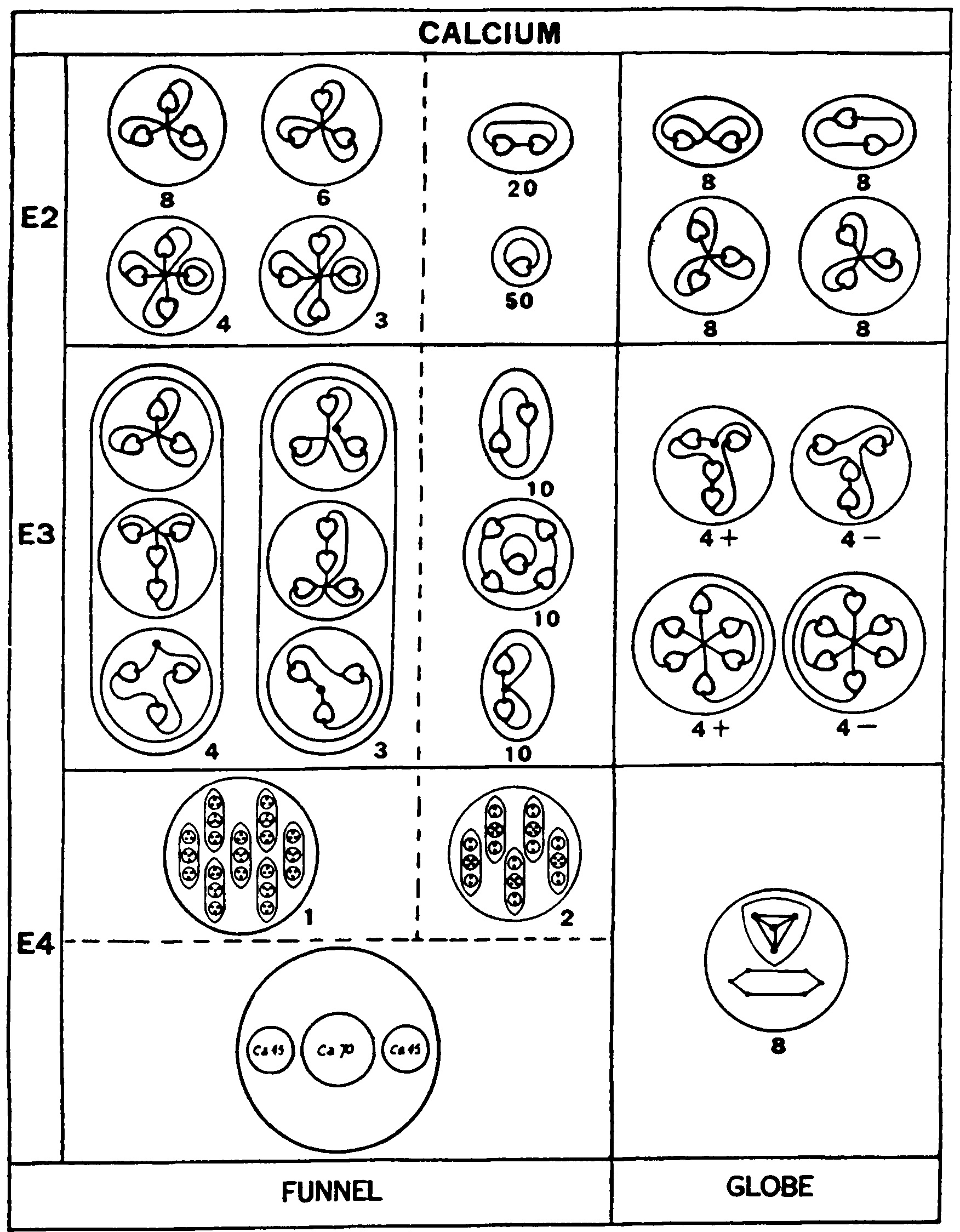
FIG.
56. DISINTEGRATION OF CALCIUM
THE
TETRAHEDRON GROUP A 113
DISINTEGRATION OF CALCIUM
Funnel. The, funnels as usual assume a spherical form on the E4 level, and show three spheres, two Ca45 and one Ca70, each containing ovoids. At the second stage these three spheres, still on the E4 level, break free from their containing funnel, and three bodies are thus liberated on the E4 level.
The sphere, Ca70, contains seven groups of ten Anu, Be10, and acts on the E3 and E2 levels as shown in Fig. 56 and under Beryllium.
On the E3 level the two spheres, Ca45, each containing five ovoids. A1.9', set free ten positive and ten negative duads and ten quintets.
On the E2 level the duads become single Anu, and the central Anu from the quintet is also set free, making fifty units in all. The remaining four Anu of the quintet divide into two duads, making 20 duads.
Globe. The central globe breaks up into eight segments on the E4 level. Each segment becomes spherical and contains within it a cigar, Ad6, and a somewhat heartshaped body. Li4. Fig. 56.
On the E3 level each segment gives eight spheres of six Anu, the cigar behaving as usual, four sextets being positive and four negative. The four Anu within the LA, which appear as a tetrahedron, remain together on the E3 level. Four positive and four negative quartets are formed.
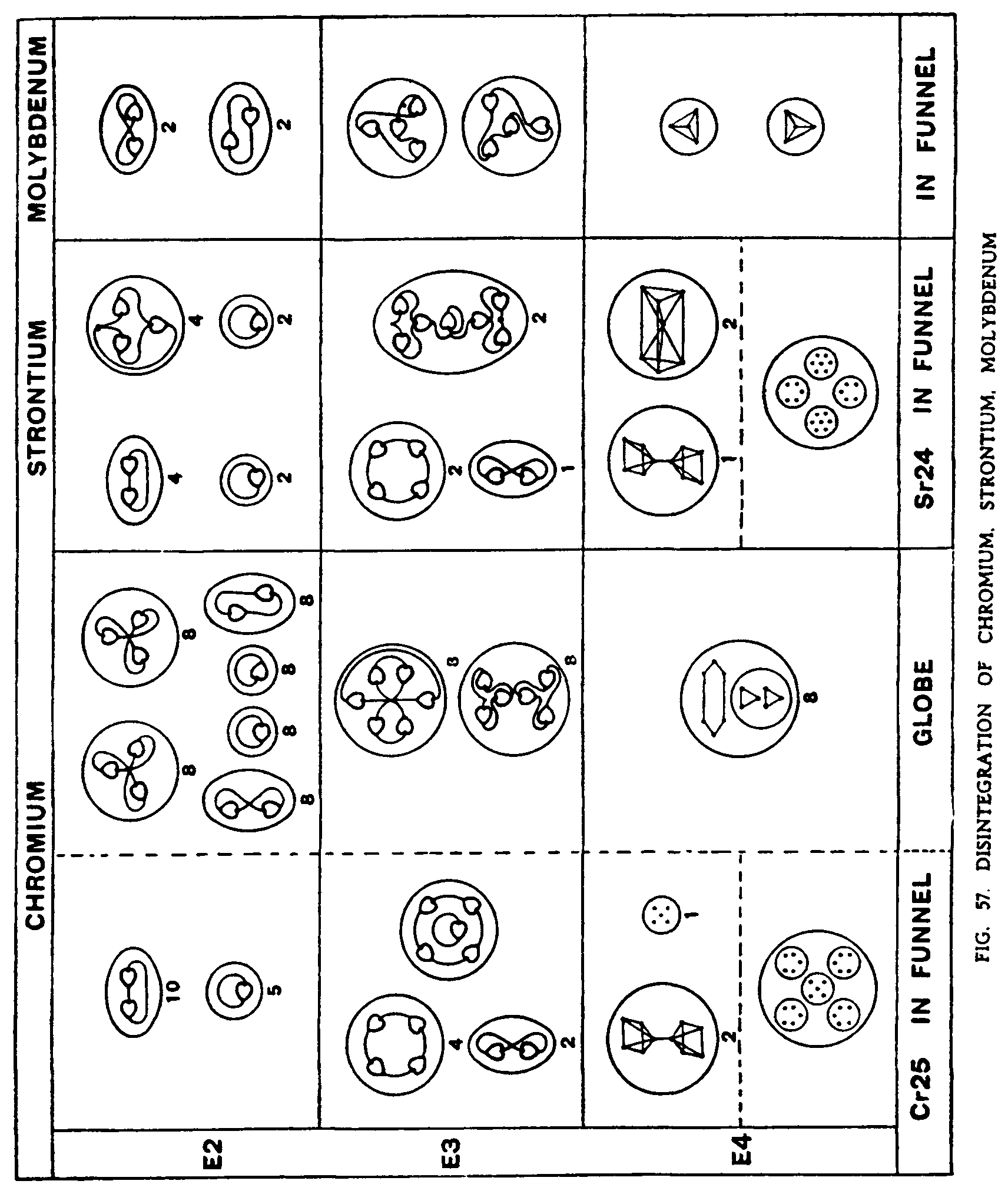
THE
TETRAHEDRON
GROUP A 115
DISINTEGRATION OF CHROMIUM
Funnel.
Each Chromium funnel contains five spheres. Three of these are in Calcium,
two Ca45 and one Ca70. Then there are two Cr25, each containing five quintets.
These five spheres are quickly set free on the E4 level The Ca45's and
Ca70's behave as in Calcium, Fig. 56. The Cr25 can be seen on closer examination
to contain two pairs of quintets which are mirror images of each other,
and a fifth quintet which is of a different type. Fig. 57.
At
the second stage of E4 each Cr25 forms two figures of ten Anu, making two
joined pyramids as in Copper. The remaining quintet is set free.
On
the E3 level each figure of ten Anu gives a dead and two quartets in a
ring. The remaining quintet makes a ring with the fifth Anu in the centre.
On
the E2 level 10 duads and 5 single Anu are set free from the Cr25.
Central
globe. In the central globe each segment is first set free, making 8 spheres
on the E4 level. Each sphere contains Ad6 and a pair of triangles as in
Hydrogen.
On
the E3 level these triangles revolve round each other, while the Ad6 acts
as usual.
On
the E2 level the triangles break up into two duads and two units, while
each Ad6 gives 2 triads.
DISINTEGRATION OF STRONTIUM
Funnels.
The Strontium funnel contains eight spheres, six as in Calcium, four Ca45
and two Ca70, and two Sr24. All these are liberated in the first stage
on the E4 level. The Ca45's and Ca70's behave as in Calcium. At the second
stage each Sr24 forms three groups. One of these is a group of ten Anu
with two pyramids with apices joined. as in Chromium, and there are two
groups of seven Anu, L7. Fig. 57.
All
these disintegrate as shown, either under Calcium or Strontium. Figs. 56
and 57. On the E4 level the joined pyramids give two quartets and a dead,
and the L7 gives a group of seven Anu as in Iodine. On the E2 level the
joined pyramids give 4 duads and 2 units as in Chromium, and each seven
gives two triads and a unit. There is really nothing new in Strontium,
only repetitions of forms already studied
DISINTEGRATION OF MOLYBDENUM
Funnels.
The funnels contain 8 spheres. The first six of these are as in Strontium,
while the last two are Mo46. In this Mo46 occur two additional groups of
four Anu arranged in the form of a tetrahedron; they occur in pairs as
object and image. Fig. 57.
On
the E3 level the tetrahedrons give quartets, and on the E2 level these
tetrahedrons each give two duads.
116
OCCULT CHEMISTRY
Fig.
58 shows the Tetrahedron Group A in a condensed form, from which the relationships
in this group can be studied.
FIG.
58. THE TETRAHEDRON GROUP A
